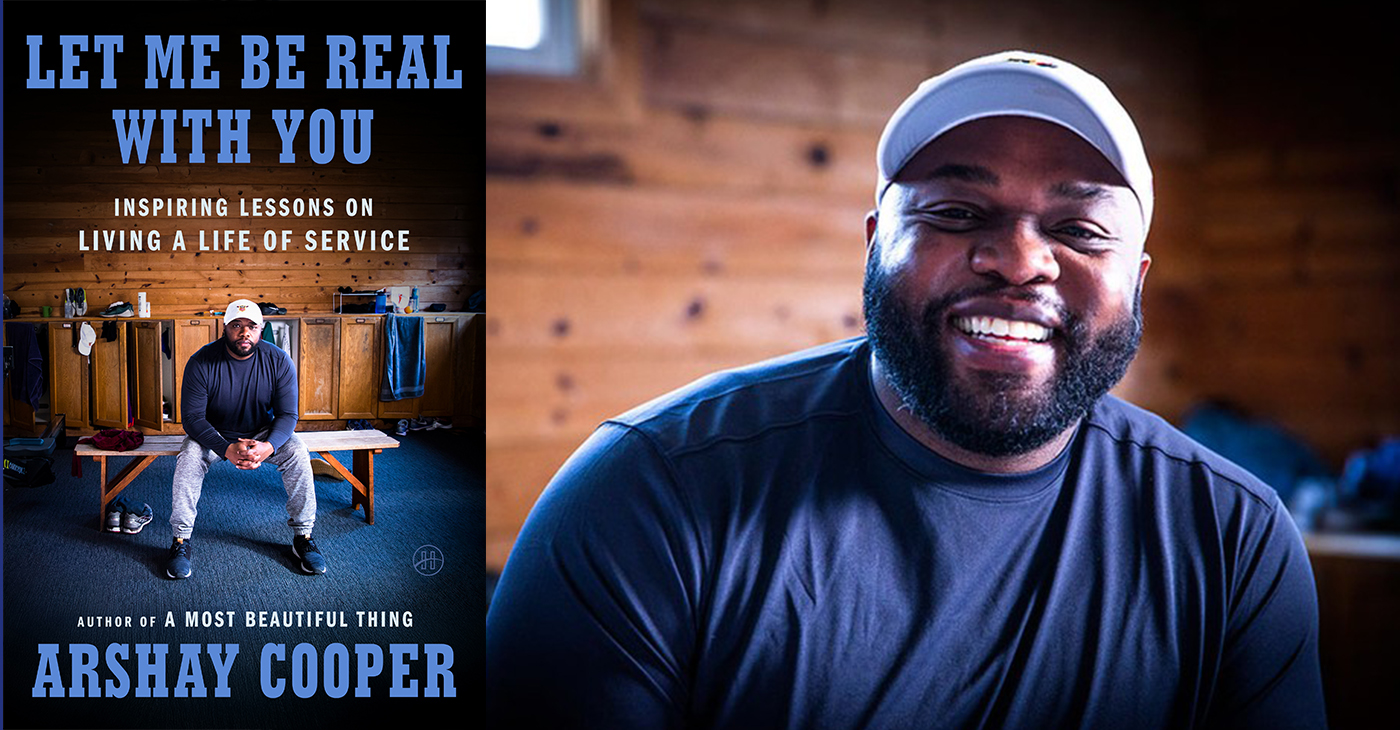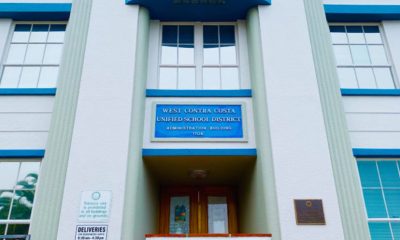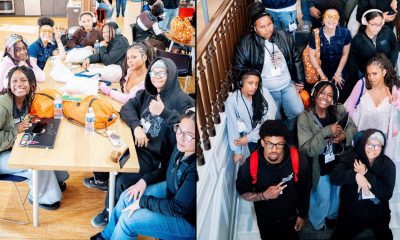Advice
Keep Safety in Mind for That Winter Walk at East Bay Regional Parks
Public safety personnel and equipment may not be able to respond easily to emergencies due to road and trail conditions, The Richmond Standard reported. The majority of East Bay Regional Parks have been closed since Jan. 4 due to recent storms and conditions. Only some shoreline and delta parks are currently open. See list at EBParks.org.

PARK IT
By Ned MacKay
Because of the series of heavy storms that have battered the region in recent days, this is a good time to emphasize winter season safety measures for park visitors.
According to the Richmond Standard, the East Bay Regional Parks District is urging the public not to enter closed parks or areas with caution tape due to storm-caused safety hazards such as downed trees, falling branches, flooding and mudslides.
Public safety personnel and equipment may not be able to respond easily to emergencies due to road and trail conditions, The Richmond Standard reported. The majority of East Bay Regional Parks have been closed since Jan. 4 due to recent storms and conditions. Only some shoreline and delta parks are currently open. See list at EBParks.org.
Entering closed parks not only risks your safety, but also those of first responders.
“Help keep yourself and first responders safe by staying out of closed parks,” East Bay Regional Park District Fire Chief Aileen Theile told The Richmond Standard. “It may not seem unsafe, but the dangers and the potential for injury or loss of life are real.”
Anyone entering Regional Parks when closed is subject to citation or arrest for violation of the Park District’s Ordinance 38.
Here are some safety tips for winter activity in the parks:
- Check the weather before you go. And go with a friend, so someone can seek help if there’s an emergency. If you go alone, be sure to tell a responsible person where you are going and when you will be back. Then inform them when you have returned. In an emergency, call 911 or 510-881-1121, 24 hours a day.
- Be prepared for changeable weather. Dress in layers, carry extra warm clothing, and wear sturdy footgear. It’s better to carry clothing you may not need than it is to need clothing you do not have.
- Bring a map and stay on the official trails. Don’t take shortcuts on unmarked paths. Maps can be downloaded from the park district website, www.ebparks.org.
While you are on the trails, watch for rockslides, fallen trees and any other hazards. The rangers try to keep on top of these situations, but there are many trails and there’s likely to be considerable storm damage. Abide by any signs warning of closure or dangers and cooperate with instructions from park district staff.
- Take a snack for an energy boost. A thermos full of a hot beverage works well, too.
- Trails will likely be muddy. Leave a pair of dry shoes in the car, along with a cardboard box for those muddy boots.
- For up-to-date information on park hazards and closures, click on “Visit a Park” at the top of the home page, then click again on “Alerts & Closures.”
With the new year comes the 30th annual outing of the East Bay Regional Park District’s always-popular Trails Challenge program. It’s free of charge, fun for all ages and levels of ability, and easy to join.
The goal is to complete any five Trails Challenge trails or 26.2 miles (same distance as a marathon) of non-challenge trails. Record the trail names and distances and submit your log to reservations@ebparks.org by Dec. 1, 2023. You’ll be rewarded with a 2023 Trails Challenge pin, while supplies last.
The program is a great way to become reacquainted with familiar regional parks or explore new ones. It’s also an incentive for enjoyable and healthy outdoor exercise.
You can download the Trails Challenge guidebook at ebparks.org/TC. It contains a list of 20 trails, graded as easy, moderate or challenging. There are trails open to hikers, bicyclists, equestrians and dog walkers. Trails Challenge 2023 also offers increased accessibility, with trails that are usable by people with mobility limitations.
Here are some examples. There are easy hikes listed for Bay Point Regional Shoreline in Bay Point and Oyster Bay Regional Shoreline in San Leandro.
For a moderate hike, there’s a trail at Sunol Regional Wilderness in southern Alameda County, and one at Lake Chabot near Castro Valley.
Challenging hikes include trails at Morgan Territory north of Livermore and Wildcat Canyon in Richmond.
Besides the detailed trail descriptions, the Trails Challenge guidebook contains useful information about trail safety, etiquette, and essential equipment.
The 30th Anniversary Trails Challenge program is made possible by support from Kaiser Permanente and the Regional Parks Foundation.
The cultural history of the Ohlone Peoples is the theme of a program from 1 to 2 p.m. on Saturday, Jan. 14, 2023, in the visitor center at Sunol Wilderness Regional Preserve with naturalist Kristina Parkison.
Drop by the Ohlone cultures informational table to learn about the rich culture and thriving present-day lifestyle of the first people who lived in what is now the park.
Sunol Regional Wilderness is at the end of Geary Road off Calaveras Road, about five miles south of I-680 and the town of Sunol. There’s a parking fee of $5 per vehicle; the program is free of charge. For information, call 510-544-3249.
With the rains come mushrooms and other fungi. Learn more during a naturalist-led “Funky Fungi” program from 11:30 a.m. to 12:30 p.m. on Saturday, Jan. 14 at Ardenwood Historic Farm in Fremont.
Find out why mushrooms grow in circles, why mushroom rings have been historically associated with fairies, and other mushroom lore. Then make your own fairy craft.
The program is free of charge and registration is not required. Ardenwood admission fees apply.
Ardenwood is at 34600 Ardenwood Blvd., just north of Highway 84. For information, call 510-544-2797.
“Old Skool Skillz” is the title of a program from 2 to 3 p.m. on Saturday, Jan. 14, 2023, at the Environmental Education Center in Tilden Nature Area near Berkeley with naturalist Anthony Fisher.
Make an elderberry flute and gain appreciation for the accomplishments of the first people to inhabit the lands of the East Bay and beyond.
The center is at the north end of Tilden’s Central Park Drive, accessible via Canon Drive from Grizzly Peak Boulevard in Berkeley. For information, call 510-544-2233.
Topics related to the ecology of the Delta will be explored during a hands-on, naturalist-led “Afternoon Adventure” program from 2 to 3 p.m. on Sunday, Jan. 15, 2023, at Big Break Regional Shoreline near Oakley. The program is free, and registration is not necessary.
Big Break is at 69 Big Break Road off Oakley’s Main Street. For information, call 510-544-3050.
It’s a good idea to check the park district website before heading out, to be sure your park is open. And stay safe when out enjoying the parks. For a full list of activities and programs planned in the regional parks, visit www.ebparks.org/things-to-do.
The Richmond Standard contributed to this report.
Advice
BOOK REVIEW: Let Me Be Real With You
At first look, this book might seem like just any other self-help offering. It’s inspirational for casual reader and business reader, both, just like most books in this genre. Dig a little deeper, though, and you’ll spot what makes “Let Me Be Real With You” stand out.

By Terri Schlichenmeyer
Author: Arshay Cooper, Copyright: c.2025, Publisher: HarperOne, SRP: $26.00, Page Count: 40 Pages
The hole you’re in is a deep one.
You can see the clouds above, and they look like a storm; you sense the wind, and it’s cold. It’s dark down there, and lonesome, too. You feel like you were born there — but how do you get out of the deep hole you’re in? You read the new book “Let Me Be Real With You” by Arshay Cooper. You find a hand-up and bring someone with you.
In the months after his first book was published, Cooper received a lot of requests to speak to youth about his life growing up on the West Side of Chicago, his struggles, and his many accomplishments. He was poor, bullied, and belittled, but he knew that if he could escape those things, he would succeed. He focused on doing what was best, and right. He looked for mentors and strove to understand when opportunities presented themselves.
Still, his early life left him with trauma. Here, he shows how it’s overcome-able.
We must always have hope, Cooper says, but hope is “merely the catalyst for action. The hope we receive must transform into the hope we give.”
Learn to tell your own story, as honestly as you know it. Be open to suggestions, and don’t dismiss them without great thought. Know that masculinity doesn’t equal stoicism; we are hard-wired to need other people, and sharing “pain and relatability can dissipate shame and foster empathy in powerful ways.”
Remember that trauma is intergenerational, and it can be passed down from parent to child. Let your mentors see your potential. Get therapy, if you need it; there’s no shame in it, and it will help, if you learn to trust it. Enjoy the outdoors when you can. Learn self-control. Give back to your community. Respect your financial wellness. Embrace your intelligence. Pick your friends and relationships wisely. “Do it afraid.”
And finally, remember that “You were born to soar to great heights and rule the sky.”
You just needed someone to tell you that.
At first look, this book might seem like just any other self-help offering. It’s inspirational for casual reader and business reader, both, just like most books in this genre. Dig a little deeper, though, and you’ll spot what makes “Let Me Be Real With You” stand out.
With a willingness to discuss the struggles he tackled in the past, Cooper writes with a solidly honest voice that’s exceptionally believable, and not one bit dramatic. You won’t find unnecessarily embellished stories or tall tales here, either; Cooper instead uses his real experiences to help readers understand that there are few things that are truly insurmountable. He then explains how one’s past can shape one’s future, and how today’s actions can change the future of the world.
“Let Me Be Real With You” is full of motivation, and instruction that’s do-able for adults and teens. If you need that, or if you’ve vowed to do better this coming year, it might help make you whole.
Advice
Support Your Child’s Mental Health: Medi-Cal Covers Therapy, Medication, and More

Advertorial
When children struggle emotionally, it can affect every part of their lives — at home, in school, with friends, and even their physical health. In many Black families, we’re taught to be strong and push through. But our kids don’t have to struggle alone. Medi-Cal provides mental health care for children and youth, with no referral or diagnosis required.
Through California Advancing and Innovating Medi-Cal (CalAIM), the state is transforming how care is delivered. Services are now easier to access and better connected across mental health, physical health, and family support systems. CalAIM brings care into schools, homes, and communities, removing barriers and helping children get support early, before challenges escalate.
Help is Available, and it’s Covered
Under Medi-Cal, every child and teen under age 19 has the right to mental health care. This includes screenings, therapy, medication support, crisis stabilization, and help coordinating services. Parents, caregivers, and children age 12 or older can request a screening at any time, with no diagnosis or referral required.
Medi-Cal’s Mental Health and Substance Use Disorder Program
For children and youth with more serious mental health needs, including those in foster care or involved in the justice system, Medi-Cal offers expanded support, including:
- Family-centered and community-based therapy to address trauma, behavior challenges, or system involvement.
- Wraparound care teams that help keep children safely at home or with relatives.
- Activity funds that support healing through sports, art, music, and therapeutic camps.
- Initial joint behavioral health visits, where a mental health provider and child welfare worker meet with the family early in a case.
- Child welfare liaisons in Medi-Cal health plans who help caregivers and social workers get services for children faster
Keeping Kids Safe from Opioids and Harmful Drugs
DHCS is also working to keep young people safe as California faces rising risks from opioids and counterfeit pills. Programs like Elevate Youth California and Friday Night Live give teens mentorship, leadership opportunities, and positive outlets that strengthen mental well-being.
Through the California Youth Opioid Response, families can learn how to avoid dangerous substances and get treatment when needed. Song for Charlie provides parents and teens with facts and tools to talk honestly about mental health and counterfeit pills.
DHCS also supports groups like Young People in Recovery, which helps youth build skills for long-term healing, and the Youth Peer Mentor Program, which trains teens with lived experience to support others. These efforts are part of California’s strategy to protect young people, prevent overdoses, and help them make healthier choices.
Support for Parents and Caregivers
Children thrive when their caregivers are supported. Through CalAIM’s vision of whole-person care, Medi-Cal now covers dyadic services, visits where a child and caregiver meet together with a provider to strengthen bonding, manage stress, and address behavior challenges.
These visits may include screening the caregiver for depression or anxiety and connecting them to food, housing, or other health-related social needs, aligning with CalAIM’s Community Supports framework. Notably, only the child must be enrolled in Medi-Cal to receive dyadic care.
Family therapy is also covered and can take place in clinics, schools, homes, or via telehealth, reflecting CalAIM’s commitment to flexible, community-based care delivery.
Additionally, BrightLife Kids offers free tools, resources, and virtual coaching for caregivers and children ages 0–12. Families can sign up online or through the BrightLife Kids app. No insurance, diagnosis, or referral is required.
For teens and young adults ages 13–25, California offers Soluna, a free mental health app where young people can chat with coaches, learn coping skills, journal, or join supportive community circles. Soluna is free, confidential, available in app stores, and does not require insurance.
CalHOPE also provides free emotional support to all Californians through a 24/7 support line at (833) 317-HOPE (4673), online chat, and culturally responsive resources.
Support at School — Where Kids Already Are
Schools are often the first place where emotional stress is noticed. Through the Children and Youth Behavioral Health Initiative (CYBHI), public schools, community colleges, and universities can offer therapy, counseling, crisis support, and referrals at no cost to families.
Services are available during school breaks and delivered on campus, by phone or video, or at community sites. There are no copayments, deductibles, or bills.
Medi-Cal Still Covers Everyday Care
Medi-Cal continues to cover everyday mental health care, including therapy for stress, anxiety, depression, or trauma; medication support; crisis stabilization; hospital care when needed; and referrals to community programs through county mental health plans and Medi-Cal health plans.
How to Get Help
- Talk to your child’s teacher, school counselor, or doctor.
- In Alameda County call 510-272-3663 or the toll-free number 1-800-698-1118 and in San Francisco call 855-355-5757 to contact your county mental health plan to request an assessment or services.
- If your child is not enrolled in Medi-Cal, you can apply at com or my.medi-cal.ca.gov.
- In a mental health emergency, call or text 988, the Suicide and Crisis Lifeline.
Every child deserves to grow up healthy and supported. Medi-Cal is working to transform care so it’s accessible, equitable, and responsive to the needs of every family.
Advice
COMMENTARY: If You Don’t Want Your ‘Black Card’ Revoked, Watch What You Bring to Holiday Dinners
From Thanksgiving to Christmas to New Year’s Day, whether it’s the dining room table or the bid whist (Spades? Uno, anyone?) table, your card may be in danger.

By Wanda Ravernell
Post Staff
From the fourth week of November to the first week in January, if you are of African descent, but particularly African American, certain violations of cultural etiquette will get your ‘Black card’ revoked.
From Thanksgiving to Christmas to New Year’s Day, whether it’s the dining room table or the bid whist (Spades? Uno, anyone?) table, your card may be in danger.
It could take until Super Bowl Sunday for reinstatement.
I don’t know much about the card table, but for years I was on probation by the ‘Aunties,’ the givers and takers of Black cards.
How I Got into Trouble
It was 1970-something and I was influenced by the health food movement that emerged from the hippie era. A vegetarian (which was then considered sacrilegious by most Black people I knew) prepared me a simple meal: grated cheese over steamed broccoli, lentils, and brown rice.
I introduced the broccoli dish at the Friday night supper with my aunt and grandfather. She pronounced the bright green broccoli undone, but she ate it. (I did not, of course, try brown rice on them.)
I knew that I would be allowed back in the kitchen when she attempted the dish, but the broccoli had been cooked to death. (Y’all remember when ALL vegetables, not just greens, were cooked to mush?)
My Black card, which had been revoked was then reattained because they ate what I prepared and imitated it.
Over the decades, various transgressions have become normalized. I remember when having a smoked turkey neck instead of a ham hock in collard greens was greeted with mumblings and murmurings at both the dining room and card tables. Then came vegan versions with just olive oil (What? No Crisco? No bacon, at least?) and garlic. And now my husband stir fries his collards in a wok.
But No Matter How Things Have Changed…
At holiday meals, there are assigned tasks. Uncle Jack chopped raw onions when needed. Uncle Buddy made the fruit salad for Easter. My mother brought the greens in winter, macaroni salad in summer. Aunt Deanie did the macaroni and cheese, and the great aunts, my deceased grandmother’s sisters, oversaw the preparation of the roast beef, turkey, and ham. My father, if he were present, did the carving.
These designations/assignments were binding agreements that could stand up in a court of law. Do not violate the law of assignments by bringing some other version of a tried-and-true dish, even if you call it a new ‘cheese and noodle item’ to ‘try out.’ The auntie lawgivers know what you are trying to do. It’s called a menu coup d’état, and they are not having it.
The time for experiments is in your own home: your spouse and kids are the Guinea pigs.
My mother’s variation of a classic that I detested from that Sunday to the present was adding crushed pineapple to mashed sweet potatoes. A relative stops by, tries it, and then it can be introduced as an add-on to the standard holiday menu.
My Aunt Vivian’s concoctions from Good Housekeeping or Ladies’ Home Journal magazine also made it to the Black people’s tables all over the country in the form of a green bean casserole.
What Not to Do and How Did It Cross Your Mind?
People are, of all things holy, preparing mac ‘n’ cheese with so much sugar it tastes like custard with noodles in it.
Also showing up in the wrong places: raisins. Raisins have been reported in the stuffing (makes no sense unless it’s in a ‘sweet meats’ dish), in a pan of corn bread, and – heresy in the Black kitchen – the MAC ‘n’ CHEESE.
These are not mere allegations: There is photographic evidence of these Black card violations, but I don’t want to defame witnesses who remained present at the scene of the crimes.
The cook – bless his/her heart – was probably well-meaning, if ignorant. Maybe they got the idea from a social media influencer, much like Aunt Viv got recipes from magazines.
Thankfully, a long-winded blessing of the food at the table can give the wary attendee time to locate the oddity’s place on the table and plan accordingly.
But who knows? Innovation always prevails, for, as the old folks say, ‘waste makes want.’ What if the leftovers were cut up, dipped in breadcrumbs and deep fried? The next day, that dish might make it to the TV tray by the card table.
An older cousin – on her way to being an Auntie – in her bonnet, leggings, T-shirt, and bunny slippers and too tired to object, might try it and like it….
And if she ‘rubs your head’ after eating it, the new dish might be a winner and (Whew!) everybody, thanks God, keeps their Black cards.
Until the next time.
-

 Alameda County4 weeks ago
Alameda County4 weeks agoSeth Curry Makes Impressive Debut with the Golden State Warriors
-

 #NNPA BlackPress4 weeks ago
#NNPA BlackPress4 weeks agoLIHEAP Funds Released After Weeks of Delay as States and the District Rush to Protect Households from the Cold
-

 #NNPA BlackPress4 weeks ago
#NNPA BlackPress4 weeks agoSeven Steps to Help Your Child Build Meaningful Connections
-

 #NNPA BlackPress4 weeks ago
#NNPA BlackPress4 weeks agoSeven Steps to Help Your Child Build Meaningful Connections
-

 #NNPA BlackPress4 weeks ago
#NNPA BlackPress4 weeks agoTrinidad and Tobago – Prime Minister Confirms U.S. Marines Working on Tobago Radar System
-

 #NNPA BlackPress4 weeks ago
#NNPA BlackPress4 weeks agoThanksgiving Celebrated Across the Tri-State
-

 #NNPA BlackPress4 weeks ago
#NNPA BlackPress4 weeks agoTeens Reject Today’s News as Trump Intensifies His Assault on the Press
-

 #NNPA BlackPress4 weeks ago
#NNPA BlackPress4 weeks agoBreaking the Silence: Black Veterans Speak Out on PTSD and the Path to Recovery
























































